FC Lugano Femminile started the season as obvious contenders for the Swiss title and possible outsiders in the 2019/20 women’s Champions League; the squad, consisting of 16 players who played in top American colleges and some young local prospects, was seen as a top team in NLA.
However, they started poorly: sitting at the bottom of the table after 5 matches and easily eliminated in Europe, with a 1-11 aggregate, by ManCity; after this shocking start, the club’s hopes were dashed even further when all the American players were forced to leave Switzerland due to work permit problems.
Massimo Migliorini was appointed as the new coach in that moment; the remaining roster was based on U19 players, so the club was seeking a coach with experience and success in player development, and he fit the bill due to his work with the U16 and U17 Italian national teams, as well as in Inter Milan women’s academy.
The Italian coach drastically changed the style of play, tactical concepts and the approach to matches, and in this tactical analysis, I will look into their uncommon attacking and defensive principles.
System and players
FC Lugano Femminile have used a 1-3-2-3-2 formation with three centre-backs and two wing-backs as well as two holding-midfielders and an offensive midfielder. Migliorini changed the midfield shape commonly seen in a 1-3-5-2 and Lugano are playing with a “triangle” with an advanced midfielder (Berthoud), supporting the two attackers, who is free to create numerical advantages either in the wide areas or in midfield.
The two forwards (local star Andreoli and the Swedish Johansson-Prakt, signed in the winter transfer window) are well balanced, technically gifted and good in 1v1 situations.
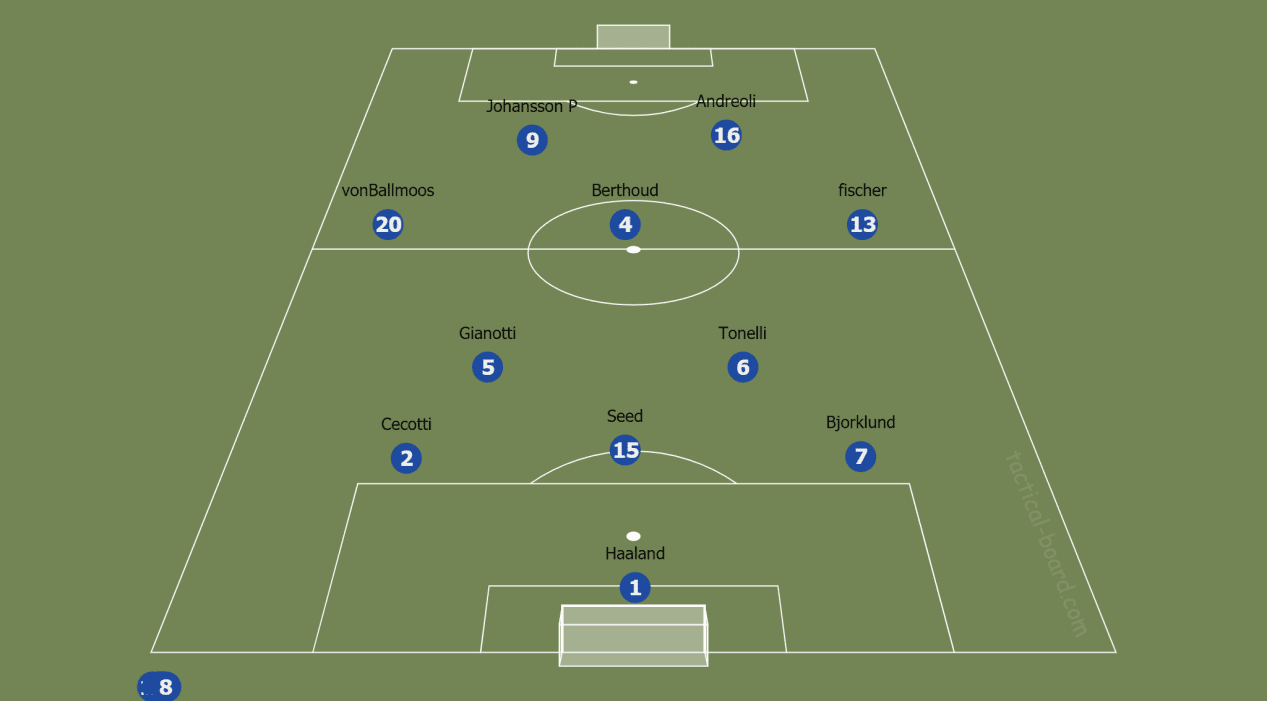
The productive winter transfer window saw Lugano welcome other newcomers in the form of midfielder Franco, centre-back Cecotti, the goalkeeper Haaland, right-wing Fischer and right-back Anna Bjorklund on loan from Sweden. Local prospects like Ubaldi, Bytyqi, Tonelli (team captain), Gianotti (2003) and vonBallmoos got real chances to show their talents.
Attacking
Lugano usually build up from the back, with the same number of players as their opponents in the first line, with the goalkeeper creating a numerical advantage. Most of the time the lateral centre-backs, Cecotti and Bjorklund, go wide while the wing-backs, one holding midfielder and the centre-back create a line of four behind the opposition forwards. If the opposition team has one striker only, the two remaining centre-backs push up in the second line, while Franco or Tonelli, the holding-mid, stays right above them, behind the opponent’s midfield.
Below an example of the build up with 2 players in the first line (2v2) and 4 players in the second line, with the free players marked in red: the right centre-back and left wing-back –
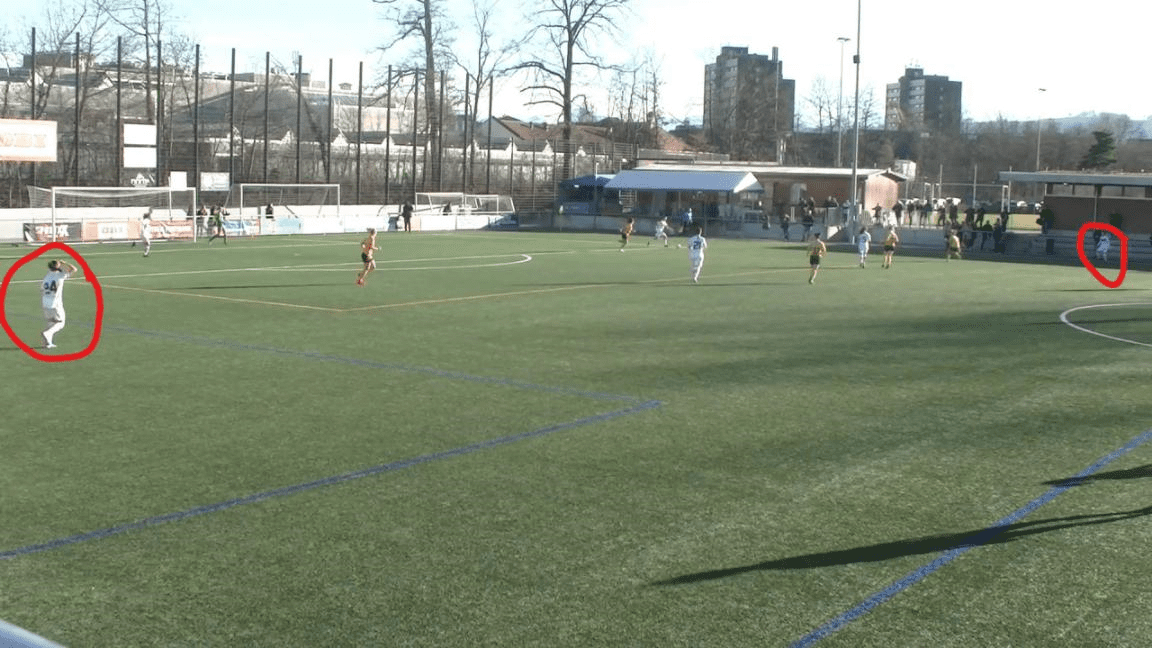
However, this approach depends on the match and the opposition structure. If the opposition team has three strikers or applies high-intensity pressure, then Seed, the centre-back, can drop into the backline, or one of the wings, equaling the opponents in numbers. In this situation four players push very high in order to attack the other team’s backline directly, bypassing the midfield with long balls. The role of the keeper is very important in ball circulation and in attracting high pressure to open spaces outside the penalty area.
Lugano tend to direct attacks down the flanks or in the centre; to get the ball there they play vertical passes as soon as the second line gets the ball. Through the well-drilled movement of the players, they are able to easily create overloads on the flanks and in the middle or in the half-spaces; this is the main way for Migliorini’s team to enter the final third.
Below an example of overload on the right flank, with 5 players involved and 2 players in the central channel ready for a possible switch of play –
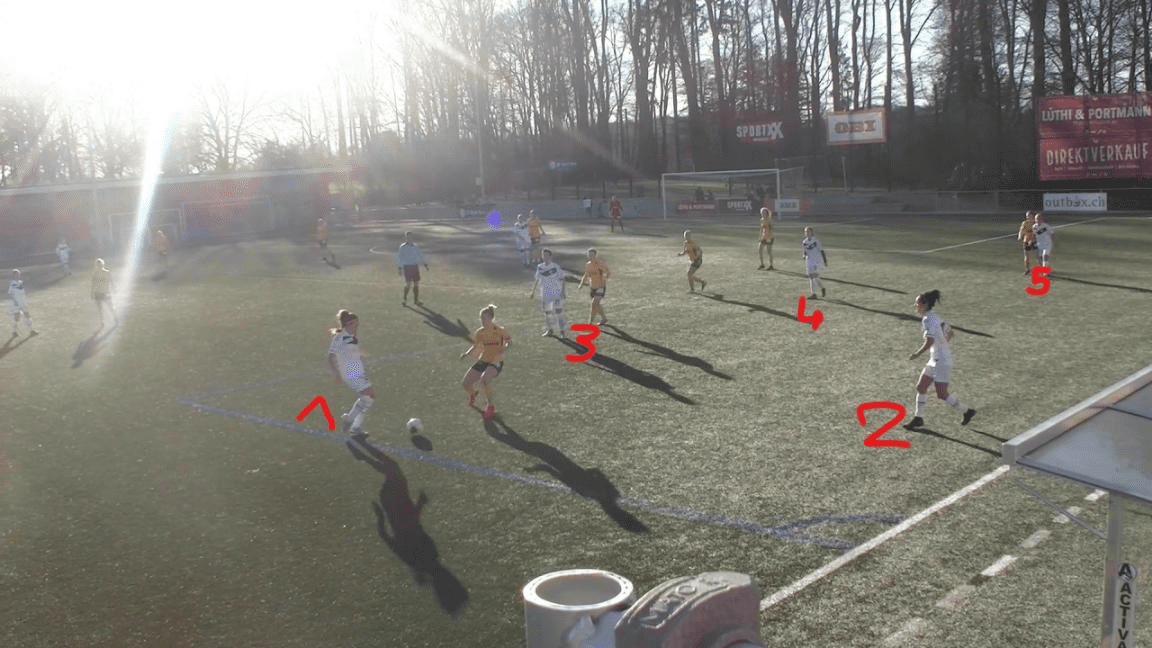
Positioning between the lines and getting a pass from the backline is the main option for the players’ movements. After receiving the pass, a player can advance further with the help of teammates who are ready to overload certain zones of the pitch, creating obvious superiority (3v2, 5v4, etc), so a one-two or a third-man run becomes a common option.
When the ball is on the flank, one of the centre-backs can push higher and underlap or overlap the wing. Then the wing-back goes vertically wide or inside and plays in the half-space. One of the forwards comes close to provide more passing options, together with two of the midfielders. These movements isolate the opposition full-back and the external midfielder and they can get outplayed very easily. Even if the opposition has three players, the involvement of so many players gives the player on the ball multiple options, with the creation of triangles and fast rotations.
Below is an example of another flank overload which forces the Young Boys striker to run back to help her teammates, reducing the numerical gap, while the right centre-back is underlapping down the right flank –
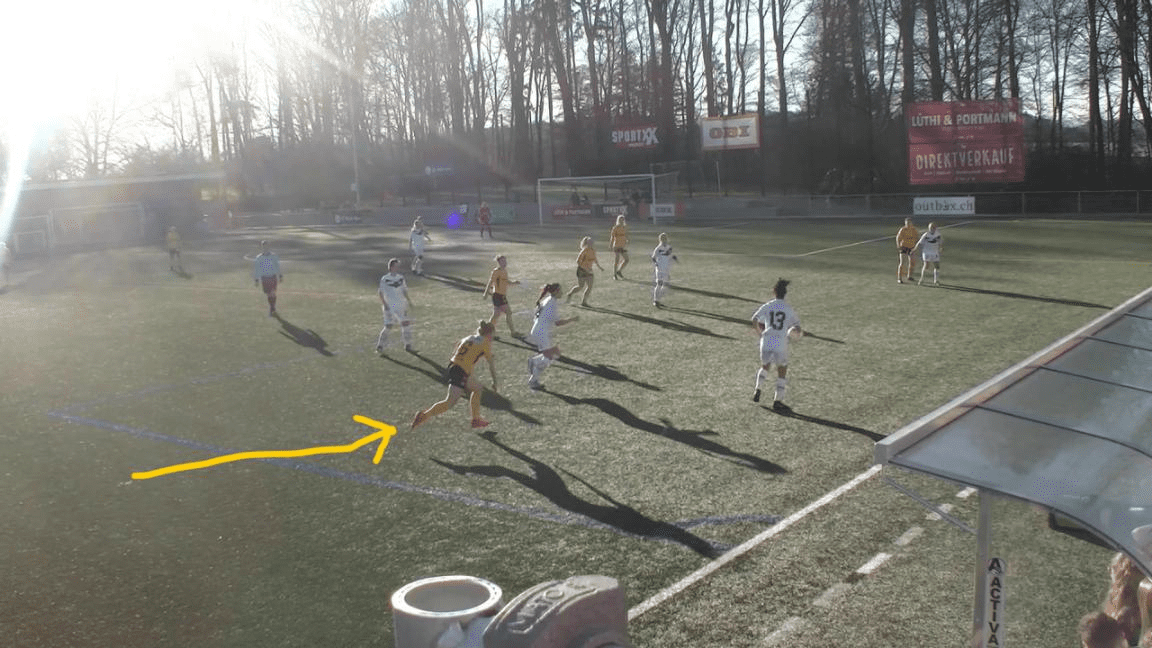
In the next section, I will look into the principles of play when they advance to the final third and the players’ movements that make the constant endangerment of the 18-yard box possible.
Final third attacking patterns
As we saw previously, Lugano create overloads on the flanks and in zone 14. The main goal is to get the ball into the penalty area, from where the chances of scoring are much higher.
Massimo Migliorini has instilled several patterns to make that happen. First of all, Lugano create overloads on the flanks and then make one-two’s or third-man runs, or overlap to get behind the defensive line. Secondly, they attack the half-spaces or the zone of the opposition centre-backs with multiple players, again by using one-two’s or third-man runs, or fast combinations to create spaces to run into the zones behind the defence. The last pattern is the switch of play from one flank to another. This is most effective when one flank has already been overloaded and congested.
Let’s start with the third option: runs made by forwards or midfielders in the pockets between the full-back and the centre-back, along with wing movements and midfielders overlapping, are all intended to exploit the flank; this kind of overload is very difficult to control for the opposition defence, as it is hard to track the movement and rotations in the half-spaces. However, if the penalty area cannot not be entered from this side, Lugano are fast to change flanks, switching the ball on to the weak side, where the width is always guaranteed by the wing-back, who gets behind the defence, running into the space behind the full-back or taking her on in a 1v1.
Below is an example of a wide attack in the final third –
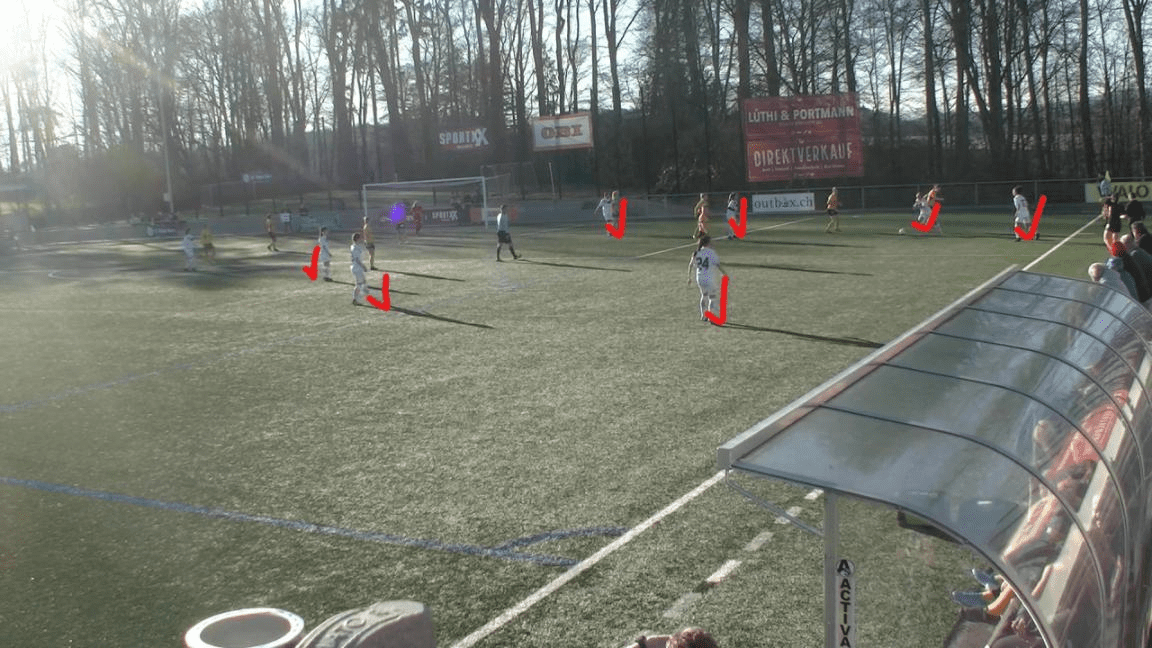
When the ball is out wide, we can see another important principle applied by Migliorini: two midfielders and the weak side wing-back are entering the penalty area, with the latter targeting the far post in her runs, and the former arriving as a second wave behind the two forwards.
Midfielders always support the attack with these runs, and so do the wing-backs; for example, if the overload is happening on the left flank, then it is very probable that Fischer will be on the far post when a cross is played in. The two forwards usually occupy the centre of the area and the near post. Crosses themselves can be directed towards the near post, at the centre or at the back of the 18-yard box, depending on the position of the crosser.
Lugano are keen on attacking through the flanks and the half-spaces. If they start an attack on one flank, they will try and work the ball around until they can enter the 18-yard box. If they are unable to penetrate, they switch the ball to the opposite flank. I already mentioned a couple of times that this team uses overloads and positional rotations in the build-up and during the attacking stage.
The involvement of Seed, the centre-back, and Haaland, the goalkeeper, in the attacks have several reasons.
Firstly, one of the centre-backs participating in the attack in the midfield zone helps outnumber the opponents in this area, restoring the old libero style of play. Secondly, when the centre-back identifies the space in the opposition’s defensive set up, she will make runs right into that space. Seed is a strong player with good technical ability, so it makes sense for her to make use of the opposition’s bad positioning.
Below an example of Seed playing in midfield –
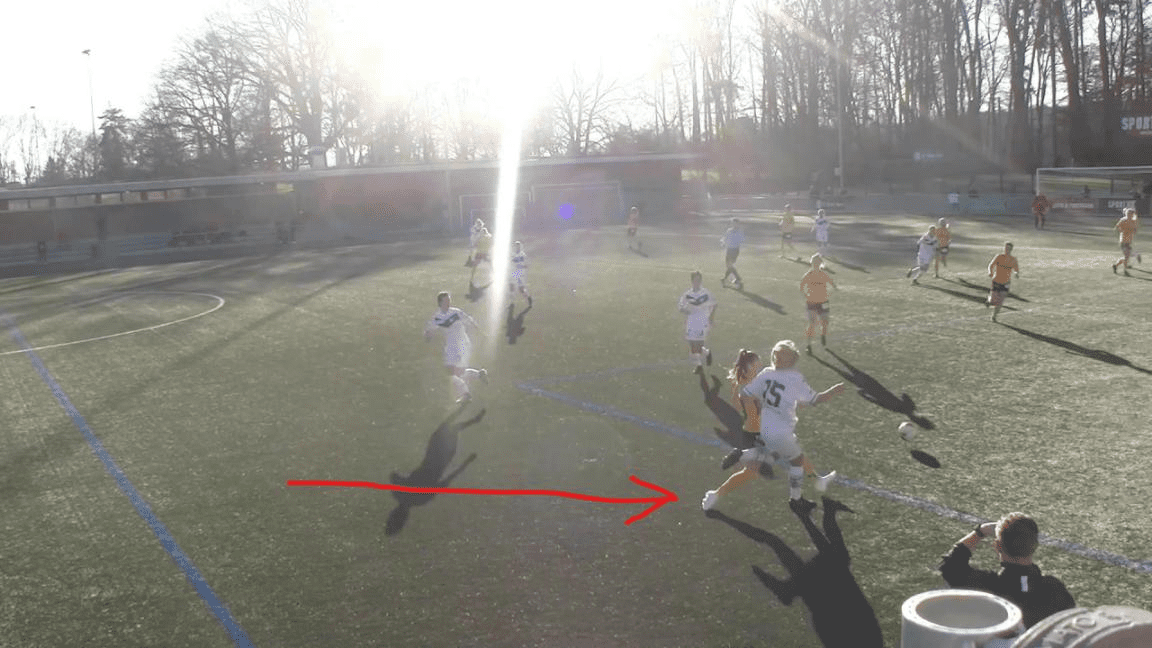
You can understand that Haaland’s passing mastery is the main reason these movements are made possible: she lures pressure, identifies the gap in the half-spaces and finds teammates with perfectly timed passes, without no fear. Many times the first line of Lugano’s build-up is comprised of just her and one centre-back, showing the faith that Migliorini has in her ball-playing abilities.
These runs are very effective, as there are usually two Lugano players on the flank already ( the wide centre-back and the wing-back), so the libero’s movement starts a rotation which allows one holding midfielder to become the third man making a run into tje blindside zone of the opposition’s second line of defenders.
Last but not least, Seed’s presence in the centre of the pitch and in the penalty area poses a real threat, as her height can provide a solid option for crosses and long balls.
These are some of the main principles of Lugano in the attack phase of play, and in the next section, I will analyse their defensive organization.
Defensive structure
Lugano’s defence has been one of the aspects which Migliorini has improved greatly as the team has progressed and achieved better results. They are last in the league in terms of conceded goals as well as in terms of xGA. Meanwhile, the stats are altered due to a lot of matches which were played without the actual starting players. In this section, I am going to look at some of the things that allow this team to be well organized defensively.
In previous sections of this analysis, I’ve looked at attacking patterns of Lugano, and one of the main ones has been Migliorini’s usage of overloads and the restoration of the libero, who plays a big role in how Lugano play out from the back. The way Migliorini sets his team up offensively might seem risky and unreasonable because if they lose the ball, they would be exposed in transition. They use a lot of players during their attacks, moreover, they use a lot of players down one flank or in the centre. However, their way of playing doesn’t really benefit the opposition if the ball is lost.
If the opposition team is playing with one striker, then she would be isolated against two centre-backs, one very aggressive while the other gives cover. If the opposition has two strikers, one of the holding midfielders helps the lateral centre-backs, covering their marking positions.
Thus, even though it might seem that Lugano are exposing themselves in defensive transitions with the way they play, in reality, they are balanced in attacking and defensive numbers; if the left or right-sided centre-back pushes forward, the far side centre-back, who is staying in the defensive line, will be helped by the central centre-back or one holding midfielder, thus always keeping three players covering the centre of the pitch.
Having the ball on one side of the pitch with so many players paves the way for great counter-pressing opportunities. Lugano have three, four, sometimes even five players to immediately press the opposition after the switch of possession. This helps to stop any signs of counter-attacks right in the beginning.
Below is an example of four players attacking the Young Boys clearance –
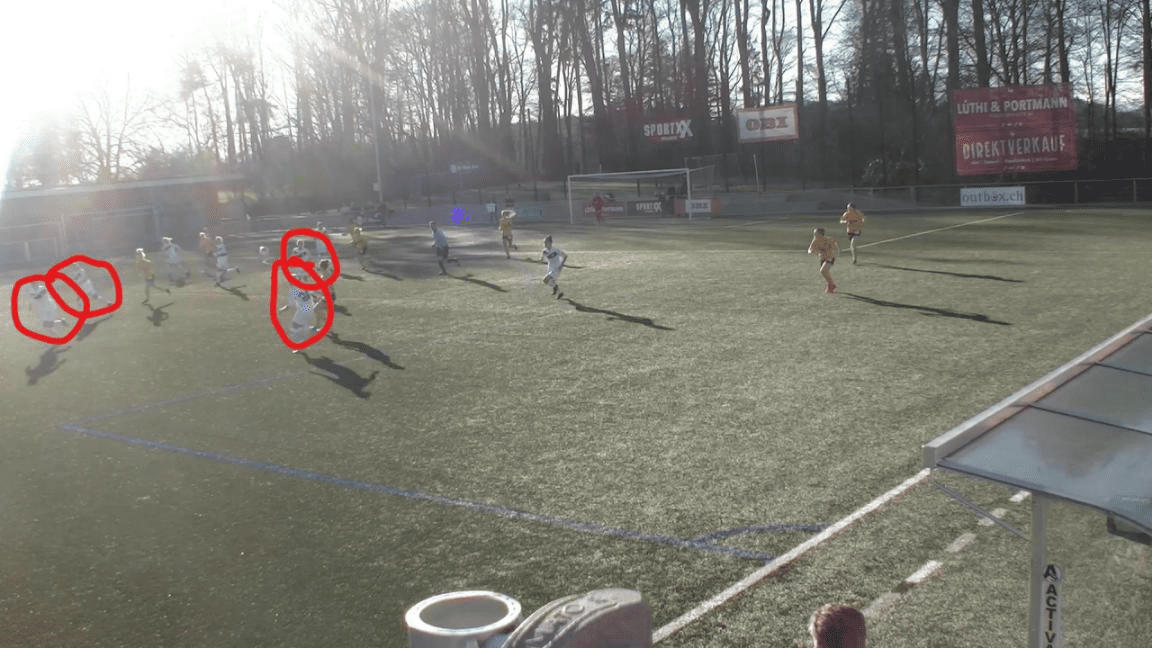
However, if the opposing team manages to bypass Lugano’s counter-press, then the whole team rolls back and forms a low block. They use a compact 5-2-1-2 formation when defending in the last 45 yards, with some use of offside traps.
The forwards form the first line of defence, preventing switches of play and long balls, while the offensive midfielder man-marks the opponent’s playmaker, while the other midfielders are in front of the backline of the defenders, controlling zone 14 and the half-spaces. The wing-backs track back and become full-backs together with the three central defenders. In the low block, the holding midfielders mark players in the half-spaces, and when the ball gets to the wide players, they help the defensive line in closing the hole opened by the lateral centre-backs’ movement towards the flanks.
Due to having five players at the back plus getting one midfielder in their 18-yard box as well, it is basically impossible to outnumber them in the penalty area, and so even if they allow the opposition to cross, it is usually harmless and results in a clearance.
In high-pressure situations, which are frequently applied in Migliorini’s system, the right and left centre-backs can step out of the line to mark and tackle players in the half-spaces or on the flanks. Midfielders, in this case, operate a little bit higher and mark the opponents’ midfielders 1v1, while the forwards put pressure on the centre-backs, and the wing-backs advance on the full-backs.
An example of a full pitch 1v1 press is shown below –
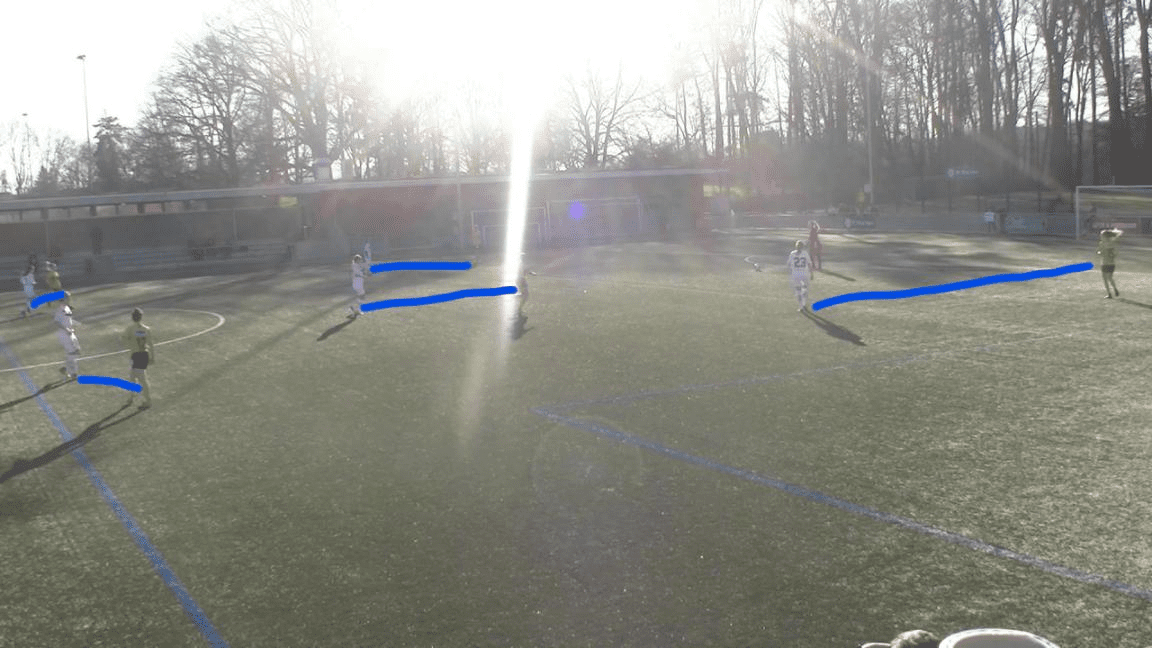
Regarding their pressing, all the players are tenacious and aggressive and their volume of defensive actions is enormous. As was mentioned, it is a man-oriented press, with fast recoveries by players bypassed by the ball. The midfielders help the centre-backs, covering their movements to mark the opposition wide players if needed. The forwards mark the opposition centre-backs, and when the opposing team manages to get up the pitch, they switch to marking the midfielders.
Their stamina, aggressiveness and tactical knowledge have put Lugano on the right path to becoming of the best teams in the NLA defensively.
Conclusion
The Cornaredo Stadium saw women’s Champions League football for the first time and there are growing signs that it will return soon. The club’s financial efforts, brilliant management and a unique playing system will allow FC Lugano Femminile to compete again for higher positions in the league, and with the right investments that have already been made and hopefully will be made in the next transfer window, Lugano have a real chance of establishing themselves on top of the NLA for years to come. Moreover, they have a lot of room for improvement and this season’s experience surely will not be the last one where they are in with a chance at the title.





Comments